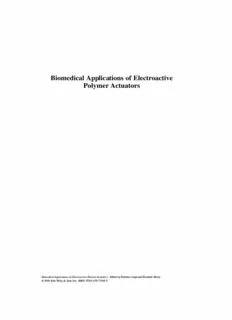
Biomedical applications of electroactive polymer actuators PDF
Preview Biomedical applications of electroactive polymer actuators
Biomedical Applications of Electroactive Polymer Actuators Biomedical Applications of Electroactive Polymer Actuators Edited by Federico Carpi and Elisabeth Smela © 2009 John Wiley & Sons Ltd. ISBN: 978-0-470-77305-5 Biomedical Applications of Electroactive Polymer Actuators FEDERICO CARPI University of Pisa, Pisa, Italy ELISABETH SMELA University of Maryland, College Park, USA A John Wiley and Sons, Ltd., Publication Thiseditionfirstpublished2009 (cid:2)2009JohnWiley&SonsLtd. Registeredoffice JohnWiley&SonsLtd,TheAtrium,SouthernGate,Chichester,WestSussex,PO198SQ,UnitedKingdom. Fordetailsofourglobaleditorialoffices,forcustomerservicesandforinformationabouthowtoapplyforpermissionto reusethecopyrightmaterialinthisbookpleaseseeourwebsiteatwww.wiley.com. TherightoftheauthortobeidentifiedastheauthorofthisworkhasbeenassertedinaccordancewiththeCopyright, DesignsandPatentsAct1988. Allrightsreserved.Nopartofthispublicationmaybereproduced,storedinaretrievalsystem,ortransmitted,inanyform orbyanymeans,electronic,mechanical,photocopying,recordingorotherwise,exceptaspermittedbytheUKCopyright, DesignsandPatentsAct1988,withoutthepriorpermissionofthepublisher. Wileyalsopublishesitsbooksinavarietyofelectronicformats.Somecontentthatappearsinprintmaynotbeavailable inelectronicbooks. Designationsusedbycompaniestodistinguishtheirproductsareoftenclaimedastrademarks.Allbrandnamesand productnamesusedinthisbookaretradenames,servicemarks,trademarksorregisteredtrademarksoftheirrespective owners.Thepublisherisnotassociatedwithanyproductorvendormentionedinthisbook.Thispublicationisdesignedto provideaccurateandauthoritativeinformationinregardtothesubjectmattercovered.Itissoldontheunderstandingthat thepublisherisnotengagedinrenderingprofessionalservices.Ifprofessionaladviceorotherexpertassistanceis required,theservicesofacompetentprofessionalshouldbesought. Thepublisherandtheauthormakenorepresentationsorwarrantieswithrespecttotheaccuracyorcompletenessofthe contentsofthisworkandspecificallydisclaimallwarranties,includingwithoutlimitationanyimpliedwarrantiesof fitnessforaparticularpurpose.Thisworkissoldwiththeunderstandingthatthepublisherisnotengagedinrendering professionalservices.Theadviceandstrategiescontainedhereinmaynotbesuitableforeverysituation.Inviewof ongoingresearch,equipmentmodifications,changesingovernmentalregulations,andtheconstantflowofinformation relatingtotheuseofexperimentalreagents,equipment,anddevices,thereaderisurgedtoreviewandevaluatethe informationprovidedinthepackageinsertorinstructionsforeachchemical,pieceofequipment,reagent,ordevicefor, amongotherthings,anychangesintheinstructionsorindicationofusageandforaddedwarningsandprecautions.The factthatanorganizationorWebsiteisreferredtointhisworkasacitationand/orapotentialsourceoffurtherinformation doesnotmeanthattheauthororthepublisherendorsestheinformationtheorganizationorWebsitemayprovideor recommendationsitmaymake.Further,readersshouldbeawarethatInternetWebsiteslistedinthisworkmayhave changedordisappearedbetweenwhenthisworkwaswrittenandwhenitisread.Nowarrantymaybecreatedorextended byanypromotionalstatementsforthiswork.Neitherthepublishernortheauthorshallbeliableforanydamagesarising herefrom. LibraryofCongressCataloging-in-PublicationData Biomedicalapplicationsofelectroactivepolymeractuators/[editedby]FedericoCarpi,ElisabethSmela. p. ; cm. Includesbibliographicalreferencesandindex. ISBN978-0-470-77305-5(H/B) 1. Polymersinmedicine. 2. Conductingpolymers 3. Actuators. I. Carpi,Federico,1975– II. Smela,Elisabeth. [DNLM:1. Polymers—diagnosticuse. 2. Polymers—therapeuticuse. 3. BiomedicalTechnology. 4. EquipmentandSupplies. QT37.5.P7B61472009] R857.P6B54852009 610.2804—dc22 2008056029 AcataloguerecordforthisbookisavailablefromtheBritishLibrary. ISBN:978-0-470-77305-5(H/B) Setin10/12ptTimesbyIntegraSoftwareServicesPvt.Ltd,Pondicherry,India. PrintedandboundinGreatBritainbyCPIAntonyRoweLtd,Chippenham,Wiltshire. Contents Preface pagexv ListofContributors xvii Introduction 1 SECTIONI POLYMERGELS 5 1 PolymerGelActuators:Fundamentals 7 PaulCalvert 1.1 IntroductionandHistoricalOverview 7 1.2 PropertiesofGels 8 1.2.1 BiologicalGels 8 1.2.2 MechanicalPropertiesofSimple,Single-PhaseGels 9 1.2.3 ElasticModuli 10 1.2.4 Strength 10 1.2.5 Multi-PhaseGels 12 1.2.6 DoubleNetworkGels 13 1.2.7 TransportProperties 14 1.2.8 Drying 15 1.3 ChemicalandPhysicalFormationofGels 16 1.4 ActuationMethods 19 1.4.1 ThermallyDrivenGelActuators 19 1.4.2 ChemicallyDrivenGelActuators 20 1.4.3 GelsDrivenbyOscillatingReactions 22 1.4.4 LightActuatedGels 23 1.4.5 ElectricallyDrivenGelActuators 23 1.4.6 Electro-andMagneto-RheologicalComposites 25 1.4.7 LCElastomers 26 1.5 PerformanceofGelsasActuators 26 1.6 ApplicationsofElectroactiveGels 30 1.6.1 GelValvesandPumps 30 1.6.2 LightModulators 30 1.6.3 GelDrugDelivery 31 1.6.4 GelSensors 32 1.7 Conclusions 32 References 33 vi Contents 2 Bio-ResponsiveHydrogelsforBiomedicalApplications 43 TomMcDonald,AlisonPatrick,RichardWilliams,BrianG.Cousinsand ReinV.Ulijn 2.1 Introduction 43 2.2 ChemicalHydrogels 44 2.3 PhysicalHydrogels 44 2.4 DefiningBio-ResponsiveHydrogels 44 2.5 Bio-ResponsiveChemicalHydrogels 46 2.5.1 ActuationBasedonChangingtheCross-Linking Density 46 2.5.2 ActuationBasedonChangesinElectrostatic Interactions 49 2.5.3 ActuationBasedonConformationalChanges 51 2.6 Bio-ResponsivePhysicalHydrogels 53 2.6.1 Enzyme-ResponsivePhysicalHydrogels 53 2.7 ElectroactiveChemicalHydrogels 56 2.8 Conclusion 57 References 57 3 Stimuli-Responsiveand‘Active’PolymersinDrugDelivery 61 AramOmerSaeed,Jo´hannesPa´llMagnu´sson, BeverleyTwaitesandCameronAlexander 3.1 Introduction 61 3.2 DrugDelivery:Examples,ChallengesandOpportunitiesforPolymers 62 3.2.1 OralDrugDeliverySystems 62 3.2.2 ParenteralDrugDelivery 63 3.2.3 TopicalandTransdermalDrugDelivery 63 3.2.4 DeliveryChallengesforBiomolecularDrugsand CellTherapeutics 64 3.2.5 PeptidesandProteins 64 3.2.6 NucleicAcids 65 3.2.7 CellDelivery 65 3.3 EmergingState-of-the-ArtMechanismsinPolymerControlled ReleaseSystems 67 3.3.1 TechnologiesforControlledDrugRelease 67 3.3.2 Polymer–DrugConjugates 67 3.3.3 Polymer–ProteinConjugates 67 3.3.4 Polymer–NucleicAcidConjugates 68 3.3.5 Polymer–NucleicAcidComplexes 68 3.4 Responsiveor‘Smart’PolymersinDrugDelivery 73 3.4.1 SolubleSmartPolymers 73 3.4.2 ResponsivePolymer–DrugConjugates 76 3.4.3 ResponsivePolymer–ProteinConjugates 76 3.4.4 ResponsivePolymersforDNADelivery 77 Contents vii 3.5 RecentHighlightsofActuatedPolymersforDrug DeliveryApplications 78 3.6 ConclusionsandFutureOutlook 80 References 81 4 ThermallyDrivenHydrogelActuatorforControllableFlowRate PumpinLong-TermDrugDelivery 89 PieroChiarelliandPietroRagni 4.1 Introduction 89 4.2 MaterialsandMethods 90 4.3 HydrogelActuator 90 4.3.1 Thermo-MechanicalGelDynamics 91 4.3.2 ExperimentalResults 93 4.4 PumpFunctioning 97 4.5 Conclusion 98 References 98 SECTIONII IONICPOLYMER–METALCOMPOSITES(IPMC) 101 5 IPMCActuators:Fundamentals 103 KinjiAsakaandKeisukeOguro 5.1 Introduction 103 5.2 Fabrication 104 5.2.1 IonicPolymer 104 5.2.2 PlatingMethods 105 5.3 Measurement 108 5.4 PerformanceoftheIPMCActuator 110 5.5 Model 113 5.6 RecentDevelopments 116 5.7 Conclusion 117 References 118 6 ActiveMicrocatheterandBiomedicalSoftDevicesBasedon IPMCActuators 121 KinjiAsakaandKeisukeOguro 6.1 Introduction 121 6.2 FabricationoftheIPMCDevice 122 6.3 ApplicationstotheMicrocatheter 124 6.4 OtherApplications 127 6.4.1 Sheet-TypeBrailleDisplay 127 6.4.2 UnderwaterMicrorobot 130 6.4.3 LinearActuatorsforaBipedWalkingRobot 134 6.5 Conclusions 135 References 135 viii Contents 7 ImplantableHeart-AssistandCompressionDevicesEmployingan ActiveNetworkofElectrically-ControllableIonicPolymer–Metal Nanocomposites 137 MohsenShahinpoor 7.1 Introduction 137 7.2 HeartFailure 139 7.3 BackgroundofIPMNCs 140 7.4 Three-DimensionalFabricationofIPMNCs 141 7.5 Electrically-InducedRoboticActuation 142 7.6 DistributedNanosensingandTransduction 144 7.7 ModelingandSimulation 146 7.8 ApplicationofIPMNCstoHeartCompressionandAssistinGeneral 149 7.9 ManufacturingThickIPMNCFingers 155 7.10 Conclusions 157 References 157 8 IPMCBasedTactileDisplaysforPressureandTexturePresentation onaHumanFinger 161 MasashiKonyoandSatoshiTadokoro 8.1 Introduction 161 8.2 IPMCActuatorsasaTactileStimulator 162 8.3 WearableTactileDisplay 164 8.4 SelectiveStimulationMethodforTactileSynthesis 165 8.5 TextureSynthesisMethod 167 8.6 DisplayMethodforPressureSensation 168 8.6.1 Method 168 8.6.2 Evaluation 168 8.7 DisplayMethodforRoughnessSensation 169 8.7.1 Method 169 8.7.2 Evaluation 170 8.8 DisplayMethodforFrictionSensation 171 8.9 SynthesisofTotalTexturalFeeling 172 8.9.1 Method 172 8.9.2 Experiments 172 8.10 Conclusions 173 References 173 9 IPMCAssistedInfusionMicropumps 175 Il-SeokPark,SoniaVohnout,MarkBanister,SangkiLee, Sang-MunKimandKwangJ.Kim 9.1 Introduction 175 9.2 BackgroundofIPMCs 176 9.3 MiniatureDisposableInfusionIPMCMicropumps 177 9.3.1 ConfigurationoftheIPMCInfusionPump 178 Contents ix 9.3.2 TheControlSystem 180 9.3.3 PerformanceTesting 181 9.4 ModellingforIPMCMicropumps 181 9.4.1 EquivalentBimorphBeamModelforIPMCActuators 181 9.4.2 IPMCDiaphragm 182 9.5 Conclusions 189 References 189 SECTIONIII CONJUGATEDPOLYMERS 193 10 ConjugatedPolymerActuators:Fundamentals 195 GeoffreyM.Spinks,GurselAlici,ScottMcGovern,BinbinXi andGordonG.Wallace 10.1 Introduction 195 10.2 MolecularMechanismsofActuationinICPs 197 10.3 ComparisonofActuationPerformanceinVariousICPs 200 10.4 ElectrochemistryofICPs 201 10.5 EffectofComposition,GeometryandElectrolyteon ActuationofPPy 204 10.5.1 EffectoftheDopantIon 204 10.5.2 EffectofSolvent 206 10.5.3 ChargeTransferProcesses 208 10.5.4 EffectofPorosity/Morphology 212 10.6 MechanicalSystemResponse 212 10.7 DeviceDesignandOptimization 217 10.7.1 HowtoTailorActuatorPerformancetoMeet DesignRequirements 217 10.7.2 DesignofaSwimmingDevice 219 10.7.3 DeviceTesting 221 10.8 FutureProspects 222 References 223 11 SteerableCatheters 229 TinaShoa,JohnD.Madden,NigelR.MunceandVictorX.D.Yang 11.1 Introduction 229 11.2 Catheters:HistoryandCurrentApplications 229 11.3 CatheterDesignChallenges 231 11.3.1 Biocompatibility 231 11.3.2 SmallSize 232 11.3.3 LowCost 232 11.3.4 StructuralRigidity 232 11.4 ActiveSteerableCatheters 234 11.4.1 Non-EAPBasedSteerableCatheters 234 11.4.2 EAPBasedSteerableCatheters 235 x Contents 11.4.3 ConjugatedPolymerBasedSteerableCatheters 237 11.5 DiscussionandConclusion 246 References 246 12 MicrofabricatedConjugatedPolymerActuatorsforMicrovalves, CellBiology,andMicrorobotics 249 ElisabethSmela 12.1 Introduction 249 12.2 ActuatorBackground 250 12.3 Microfabrication 251 12.4 SingleHingeBilayerDevices:FlapsandLids 253 12.4.1 BilayerActuators 254 12.4.2 DrugDelivery 254 12.4.3 CellManipulation 255 12.4.4 Cell-BasedSensors 256 12.5 Multi-BilayerDevices:PositioningTools 257 12.5.1 Microtools 257 12.5.2 Microrobot 257 12.6 SwellingFilmDevices:Valves 258 12.6.1 Out-of-PlaneActuationStrain 259 12.6.2 Microvalve 259 12.7 Lifetime 260 12.8 IntegratedSystems 260 12.9 Conclusions 261 References 261 13 ActuatedPinsforBrailleDisplays 265 GeoffreyM.SpinksandGordonG.Wallace 13.1 Introduction 265 13.2 RequirementsfortheElectronicBrailleScreen 266 13.3 MechanicalAnalysisofActuatorsOperatingAgainstSprings 268 13.4 PolypyrroleActuatorsforElectronicBraillePins 271 13.5 OtherPolymerActuationSystemsforElectronicBraillePins 274 13.6 Summary 275 Acknowledgements 276 References 276 14 NanostructuredConductingPolymerBiomaterialsandTheir ApplicationsinControlledDrugDelivery 279 MohammadRezaAbidianandDavidC.Martin 14.1 Introduction 279 14.2 NanostructuredConductingPolymers 280 14.2.1 Fabrication 280 14.2.2 BiomedicalApplication 282 Contents xi 14.3 ConductingPolymerNanotubesforControlledDrug Delivery 285 14.3.1 Electrospinning 286 14.3.2 ElectrospinningofDexamethasone-LoadedTemplate PLGANanofibers 287 14.3.3 ElectrochemicalDepositionofPEDOTNanotubes 288 14.3.4 ControlledDrugDeliveryfromPEDOTNanotubes 289 14.4 Conclusions 293 Acknowledgements 293 References 293 15 IntegratedOralDrugDeliverySystemwithValveBasedonPolypyrrole 301 ThorstenGo¨ttscheandStefanHaeberle 15.1 Introduction 301 15.2 SystemConcept 303 15.3 OsmoticPressurePump 305 15.3.1 ValveClosed 305 15.3.2 ValveOpen 306 15.4 PolypyrroleinActuatorApplications 307 15.4.1 WhyPPyintheIntelliDrugSystem 307 15.4.2 ActuationofPPy 308 15.5 ValveConceptsEvaluatedintheCourseoftheIntelliDrugProject 310 15.5.1 Wafer-LevelFabricatedMembraneValve 310 15.5.2 Micro-AssembledMembraneValve 311 15.6 TotalAssemblyandClinicalTestingoftheIntelliDrugSystem 314 Acknowledgement 315 References 316 SECTIONIV PIEZOELECTRICANDELECTROSTRICTIVEPOLYMERS317 16 PiezoelectricandElectrostrictivePolymerActuators:Fundamentals 319 ZhiminLiandZhongyangCheng 16.1 Introduction 319 16.2 FundamentalsofElectromechanicalMaterials 320 16.2.1 PiezoelectricEffect 320 16.2.2 ElectrostrictiveEffect 321 16.2.3 OtherEffects 323 16.3 MaterialPropertiesRelatedtoElectromechanicalApplications 324 16.3.1 ElectromechanicalCouplingFactor(k) 325 16.3.2 ElasticResponse 326 16.3.3 FrequencyandTemperatureResponses 326 16.4 TypicalElectromechanicalPolymersandTheirProperties 328 16.4.1 PiezoelectricPolymers 328 16.4.2 ElectrostrictivePolymers 330
Description: